coolant CHEVROLET MALIBU 1997 5.G Owners Manual
[x] Cancel search | Manufacturer: CHEVROLET, Model Year: 1997, Model line: MALIBU, Model: CHEVROLET MALIBU 1997 5.GPages: 354, PDF Size: 18.87 MB
Page 9 of 354

Downloaded from www.Manualslib.com manuals search engine 1
Vehicle Symbols
These are some of the symbols you may find on your vehicle.
For example,
these symbols
are used
on an
original battery:
POSSIBLE A
CAUTION
INJURY
PROTECT EYES BY
SHIELDING
Q
CAUSTIC
BURNS
AVO1 D
SPARKS
OR
FLAMES
SPARK
OR ,111,
COULD [-sr=l
FLAME
EXPLODE BAlTERY
...
These symbols
are important
for you and
your passengers
whenever your vehicle
is
driven:
DOOR LOCK
UNLOCK
These symbols
have
to do with
your lamps:
SIGNALS @ e
TURN
FOG LAMPS
$0
These symbols are
on some of
your controls:
WINDSHIELD
WIPER
WINDSHIELD DEFROSTER
WINDOW
DEFOGGER
VENTILATING FAN
These symbols
are used on
warning
and
indicator lights:
ENGINE t
COOLANT kt-
TEMP -
CHARGING I-1
BAlTERY
SYSTEM
BRAKE (@)
COOLANT a
ENGINE OIL e,
PRESSURE
ANTI-LOCK
(a)
BRAKES
Here are some
other symbols
you may see:
FUSE
P
LIGHTER
HORN
)cr
SPEAKER
Er
FUEL B
Page 58 of 354
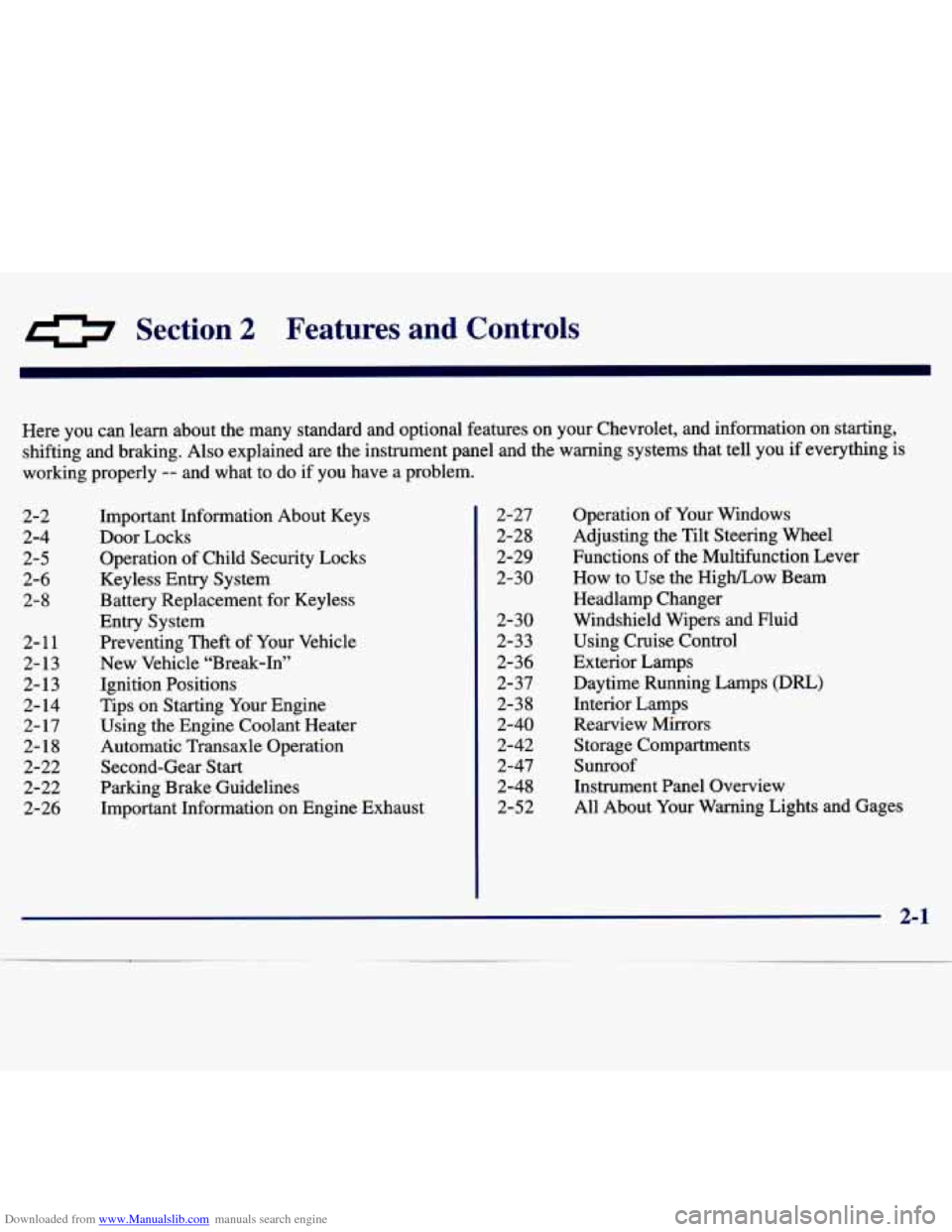
Downloaded from www.Manualslib.com manuals search engine Section 2 Features and Controls
2-2
2-4
2-5
2-6 2- 8
2-1
1
2-13 2-13
2- 14
2-
17
2-18
2-22
2-22
2-26
Here you can learn about the many standard and optional featur\
es on your Chevrolet, and information
on starting,
shifting and braking. Also explained are the instrument panel and the warning systems that tell you if everything is
working properly
-- and what to do if you have a problem.
Important Information About Keys
Door Locks Operation of Child Security Locks
Keyless Entry System
Battery Replacement for Keyless
Entry System
Preventing Theft
of Your Vehicle
New Vehicle “Break-In”
Ignition Positions
Tips on Starting Your Engine
Using the Engine Coolant Heater
Automatic Transaxle Operation
Second-Gear Start
Parking Brake Guidelines
Important Information on Engine Exhaust 2-27
2-28
2-29
2-30
2-30
2-33
2-36 2-37
2-3 8
2-40
2-42
2-47
2-48
2-52 Operation
of Your Windows
Adjusting the Tilt Steering Wheel
Functions of the Multifunction Lever
How to Use the High/Low Beam
Headlamp Changer
Windshield Wipers and Fluid
Using Cruise Control
Exterior Lamps Daytime Running Lamps (DRL)
Interior Lamps Rearview Mirrors
Storage Compartments
Sunroof
Instrument Panel Overview
All About Your Warning Lights and Gages
Page 74 of 354
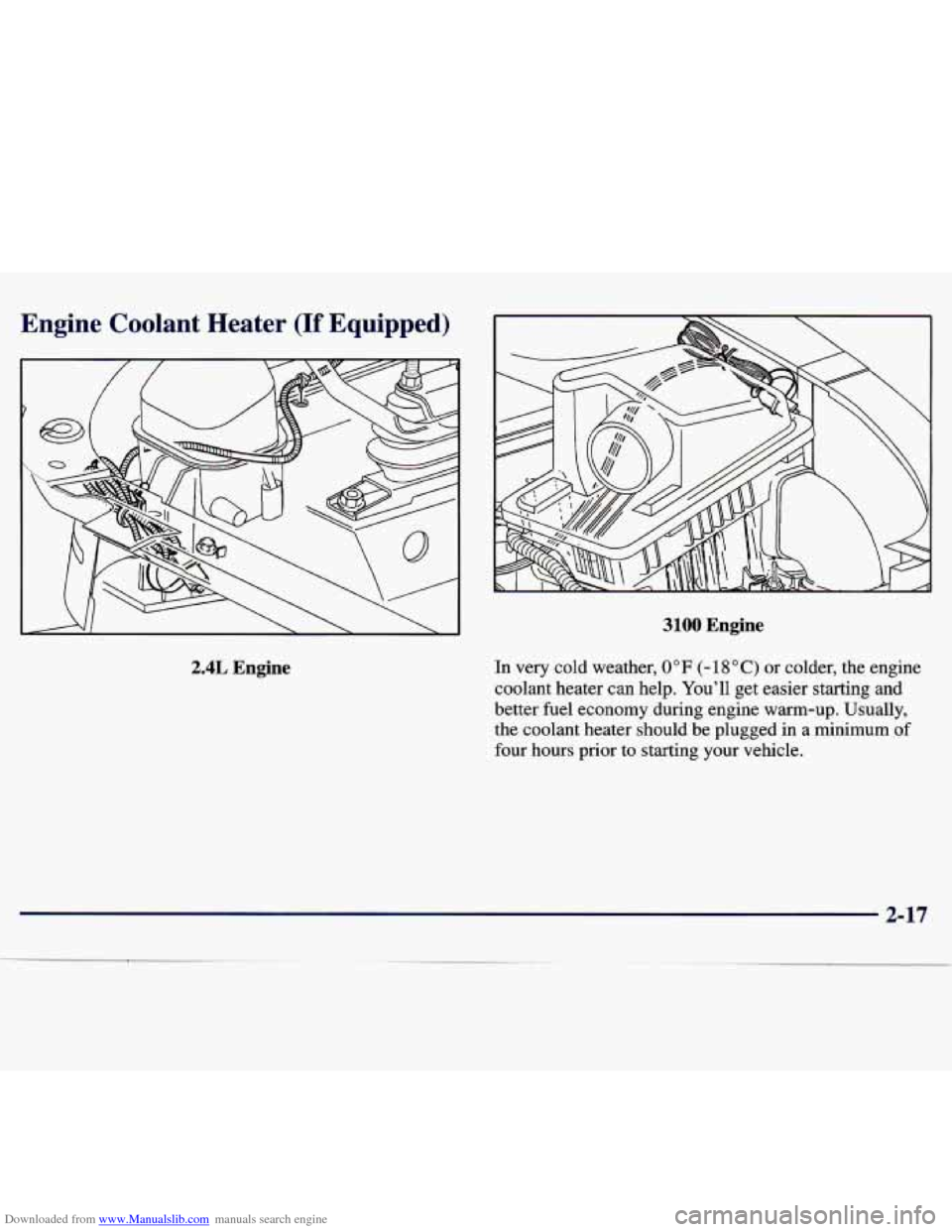
Downloaded from www.Manualslib.com manuals search engine Engine Coolant Heater (If Equipped)
2.4L Engine
3100 Engine
In very cold weather, 0°F (- 18 "C) or colder, the engine
coolant heater can help. You'll get easier starting and
better fuel economy during engine warm-up. Usually,
the coolant heater should be plugged in
a minimum of
four hours prior to starting your vehicle.
2-17
Page 75 of 354
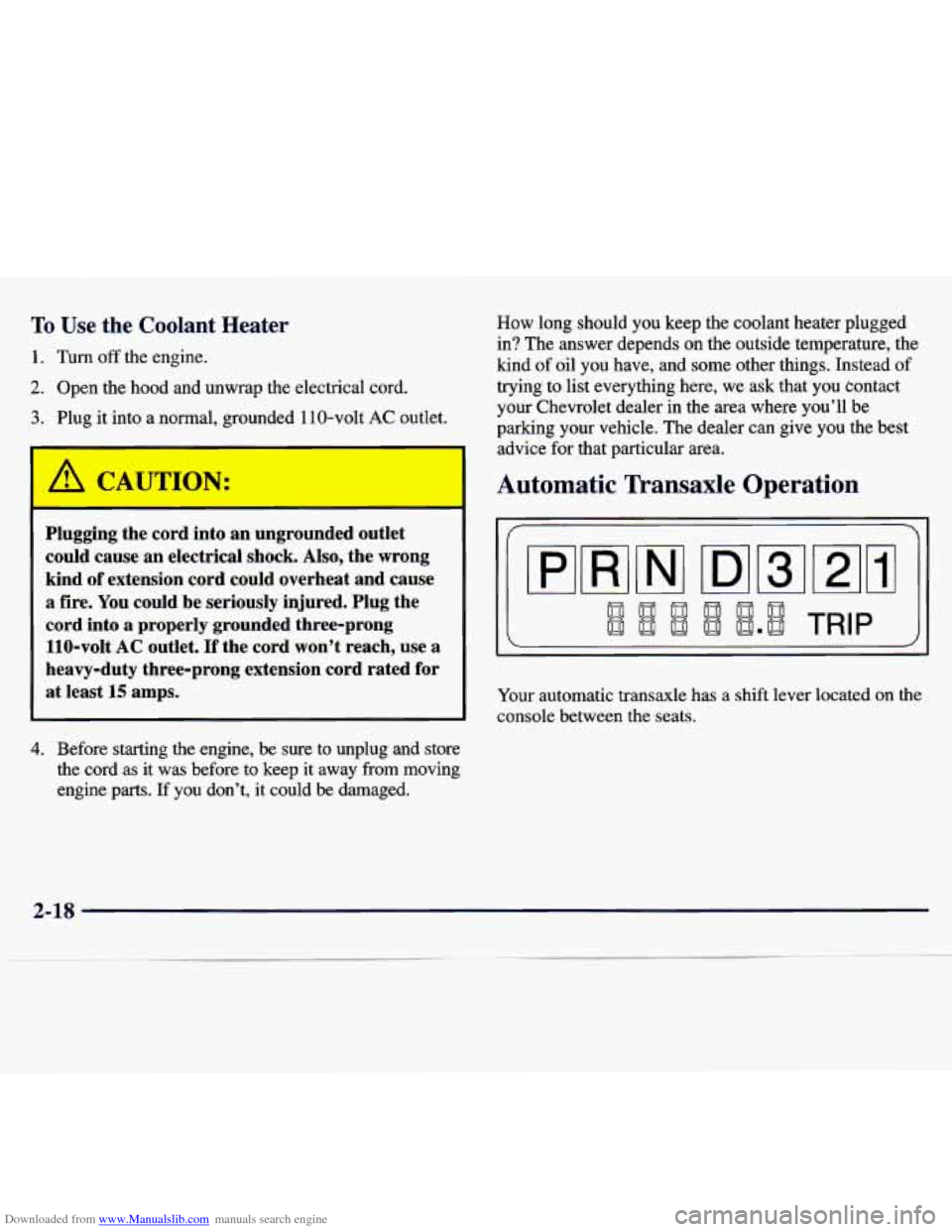
Downloaded from www.Manualslib.com manuals search engine To Use the Coolant Heater
1. Turn off the engine.
2. Open the hood and unwrap the electrical cord.
3. Plug it into a normal, grounded 1 10-volt AC outlet.
A CAUL :ON:
Plugging the cord into an ungrounded outlet
could cause an electrical shock. Also, the
wrong
kind of extension cord could overheat and cause
a fire. You could be seriously injured. Plug the
cord into a properly grounded three-prong 110-volt
AC outlet. If the cord won’t reach, use a
heavy-duty three-prong extension cord rated for
at least 15 amps.
4. Before starting the engine, be sure to unplug and store
the cord as it was before to keep it away from moving
engine parts.
If you don’t, it could be damaged. How long should you keep the coolant heater plugged
in?
The answer depends on the outside temperature, the
kind of oil you have, and some other things. Instead of
trying to list everything here, we ask that you contact
your Chevrolet dealer in the area where you’ll be
parking your vehicle. The dealer can give you the best
advice for that particular area.
Automatic Transaxle Operation
Your automatic transaxle has a shift lever located on the
console between the seats.
2-18
Page 113 of 354

Downloaded from www.Manualslib.com manuals search engine Anti-Lock Brake System Warning Light
With the anti-lock brake system, this light will come
on when you
turn your
ignition on or start your
engine and it will stay on
for three seconds.
That’s normal.
If the light stays on, turn the ignition to OFF. Or, if the
light comes on and
the chime sounds when you’re
driving, stop
as soon as possible and turn the ignition
off. Then start the engine again to reset the system. If
the light still stays on, or comes on again while you’re
driving, your Chevrolet needs service.
If the regular
brake system warning light isn’t on, you still have
brakes, but you don’t have anti-lock brakes. If the
regular brake system warning light is also on, you don’t
have anti-lock brakes and there’s a problem with your
regular brakes. See “Brake System Warning Light”
earlier in this section. The anti-lock brake system warning
light shoula come
on briefly when you
turn the ignition key to ON. If the
light doesn’t come on then, have it fixed
so it will be
ready to warn you
if there is a problem.
Engine Coolant Temperature Gage
0
This gage shows the engine
coolant temperature.
If the
gage pointer moves into the
red area, the light comes on and you hear
a chime, your
engine is too hot! It means
that your engine coolant
has overheated.
If you have been operating your vehicle under normal
driving conditions, you should pull
off the road, stop
your vehicle and turn
off the engine as soon as possible.
In “Problems on the Road,” this manual shows what to
do. See “Engine Overheating” in the Index.
2-56
Page 114 of 354
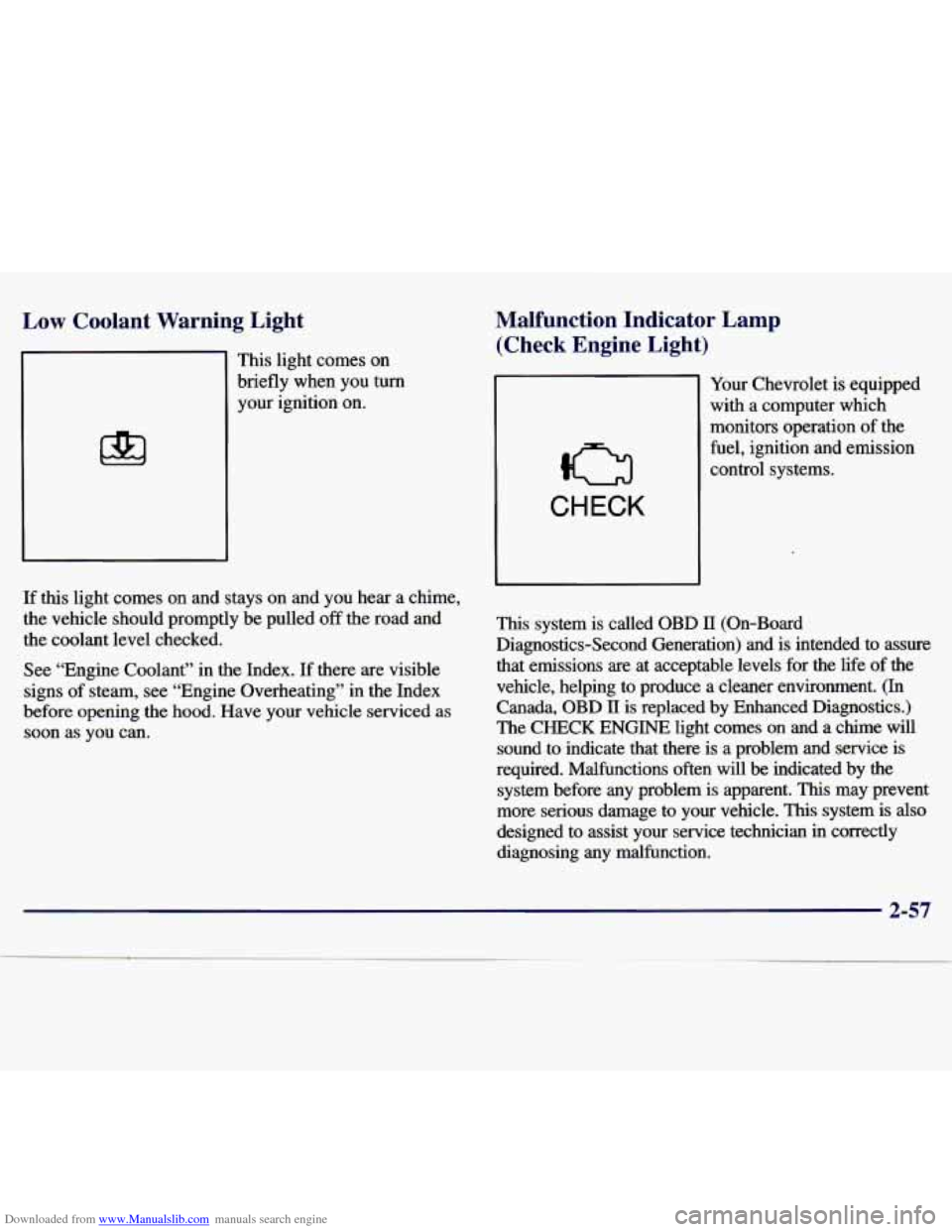
Downloaded from www.Manualslib.com manuals search engine Low Coolant Warning Light
This light comes on
briefly when you turn
If this light comes on and stays on and you hear a chime,
the vehicle should promptly be pulled
off the road and
the coolant level checked.
See “Engine Coolant” in the Index.
If there are visible
signs of steam, see “Engine Overheating”
in the Index
before opening the hood. Have your vehicle serviced as soon as you can.
Malfunction Indicator Lamp
(Check Engine Light)
CHECK
Your Chevrolet is equipped
with a computer which
monitors operation of the
fuel, ignition and emission
control systems.
This system is called OBD 11 (On-Board
Diagnostics-Second Generation) and is intended to assure
that emissions are at acceptable levels for the life of the
vehicle, helping to produce a cleaner environment. (In
Canada, OBD
II is replaced by Enhanced Diagnostics.)
The CHECK ENGINE light comes on and a chime will
sound to indicate that there is a problem and service is
required. Malfunctions often will be indicated by the
system before any problem is apparent.
This may prevent
more serious damage to your vehicle.
This system is also
designed to assist your service technician
in correctly
diagnosing any malfunction.
2-57
Page 125 of 354
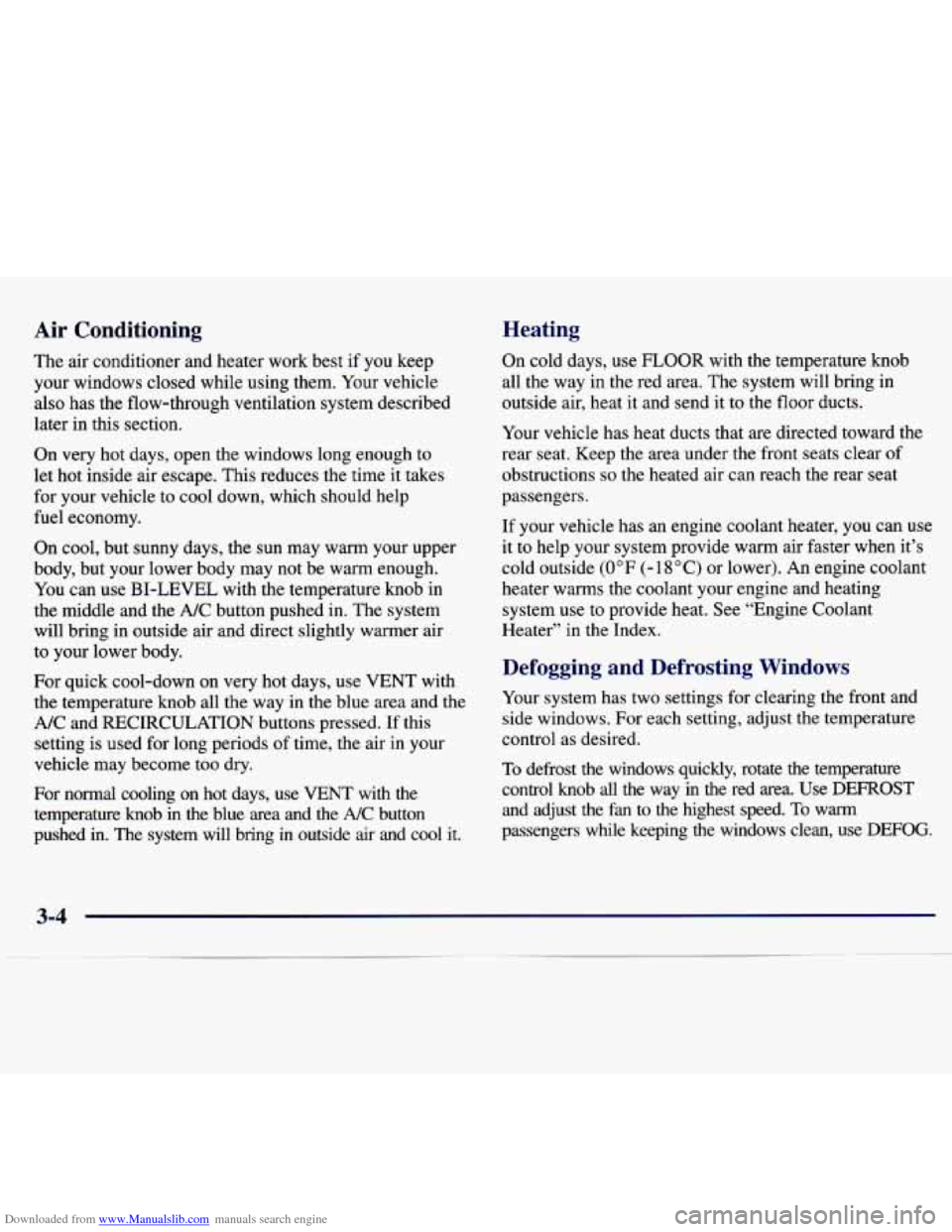
Downloaded from www.Manualslib.com manuals search engine Air Conditioning Heating
On cold
days, use FLOOR with the temperature knob
all the way in the red area. The system will bring in
outside air, heat it and send it to the floor ducts.
The
air conditioner and heater work best if you keep
your windows closed while using them. Your vehicle also has the flow-through ventilation system described
later in this section.
On very hot days, open the windows long enough to
let hot inside air escape. This reduces the time it takes
for your vehicle to cool down, which should help
fuel economy.
On cool, but sunny days, the sun may warm your upper
body, but your lower body may not be
warm enough.
You can use
BI-LEVEL with the temperature knob in
the middle and the A/C button pushed in. The system
will bring in outside air and direct slightly warmer air
to your lower body.
For quick cool-down on very hot days, use
VENT with
the temperature knob all the way in the blue area and the
A/C and RECIRCULATION buttons pressed. If this
setting is used for long periods of time, the air in your
vehicle may become too dry.
For normal cooling on hot days, use
VENT with the
temperature knob in the blue area and the
NC button
pushed
in. The system will bring in outside air and cool it.
Your vehicle has heat ducts that are directed toward the
rear seat. Keep the area under the front seats clear
of
obstructions so the heated air can reach the rear seat
passengers.
If your vehicle has an engine coolant heater, you can use it to help your system provide warm air faster when it’s
cold outside
(0°F (-18°C) or lower). An engine coolant
heater warms the coolant your engine and heating system use to provide heat. See “Engine Coolant
Heater” in the Index.
Defogging and Defrosting Windows
Your system has two settings for clearing the front and
side windows. For each setting, adjust the temperature
control as desired.
To defrost the windows quickly, rotate the temperature control knob
all the way in the red area. Use DEFROST
and adjust the fan to the highest speed. To warm
passengers while keeping the windows clean, use DEFOG.
3-4
Page 186 of 354
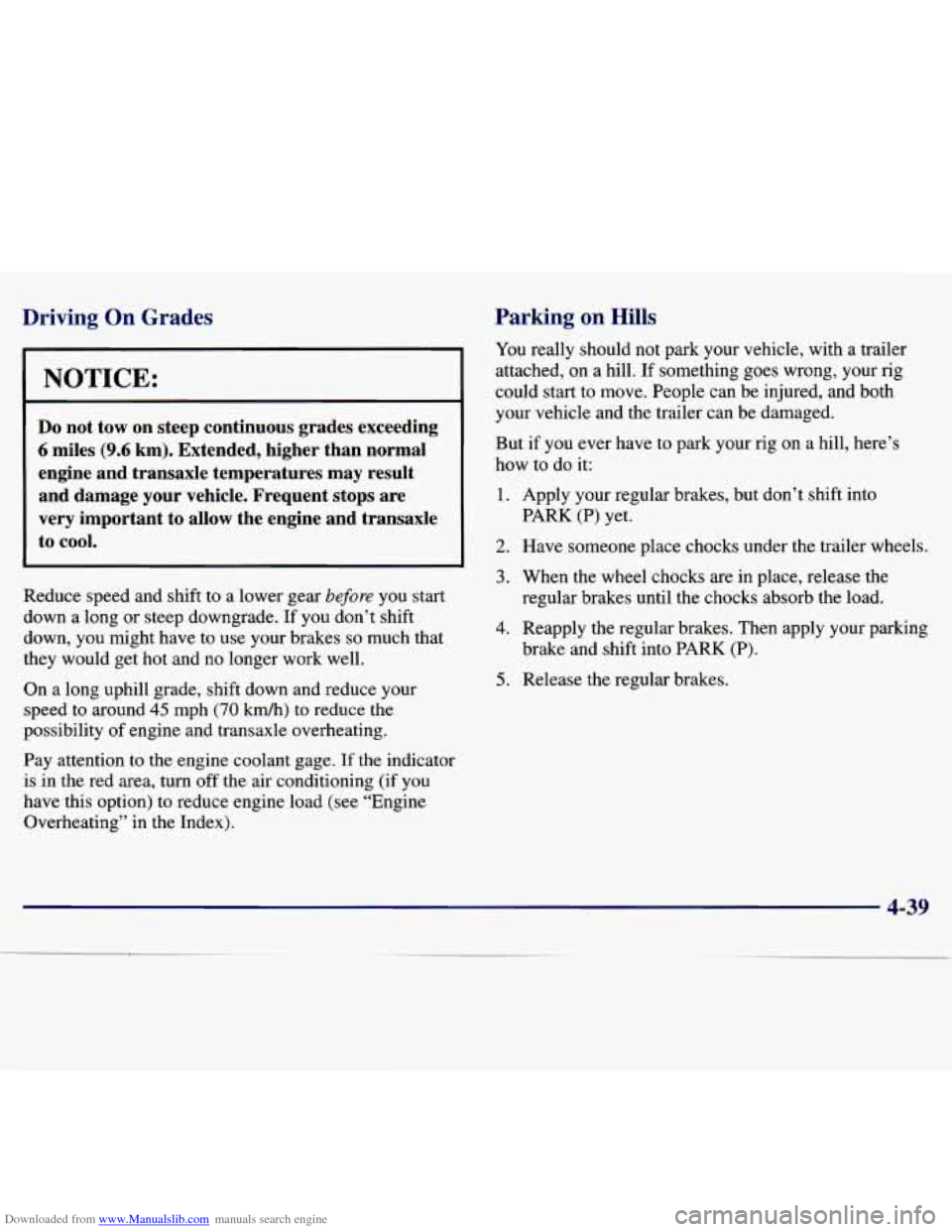
Downloaded from www.Manualslib.com manuals search engine Driving On Grades
NOTICE:
Do not tow on steep continuous grades exceeding
6 miles (9.6 km). Extended, higher than normal
engine and transaxle temperatures may result
and damage your vehicle. Frequent stops are
very important to allow the engine and transaxle
to cool.
Reduce speed and shift to a lower gear before you start
down a long or steep downgrade. If you don’t shift
down, you might have to use your brakes
so much that
they would get hot and no longer work well.
On a long uphill grade, shift down and reduce your
speed to around
45 mph (70 kmh) to reduce the
possibility of engine and transaxle overheating.
Parking on Hills
You really should not park your vehicle, with a trailer
attached, on a hill.
If something goes wrong, your rig
could start to move. People can be injured, and both
your vehicle and the trailer can be damaged.
But if you ever have to park your rig
on a hill, here’s
how to do it:
1. Apply your regular brakes, but don’t shift into
2. Have someone place chocks under the trailer wheels.
3. When the wheel chocks are in place, release the
regular brakes until the chocks absorb the load.
brake and shift into PARK
(P).
PARK (P) yet.
4. Reapply the regular brakes. Then apply your parking
5. Release the regular brakes.
Pay attention to the engine coolant gage. If the indicator
is in the red area, turn off the air conditioning (if you
have this option) to reduce engine load (see “Engine
Overheating” in the Index).
4-39
Page 188 of 354
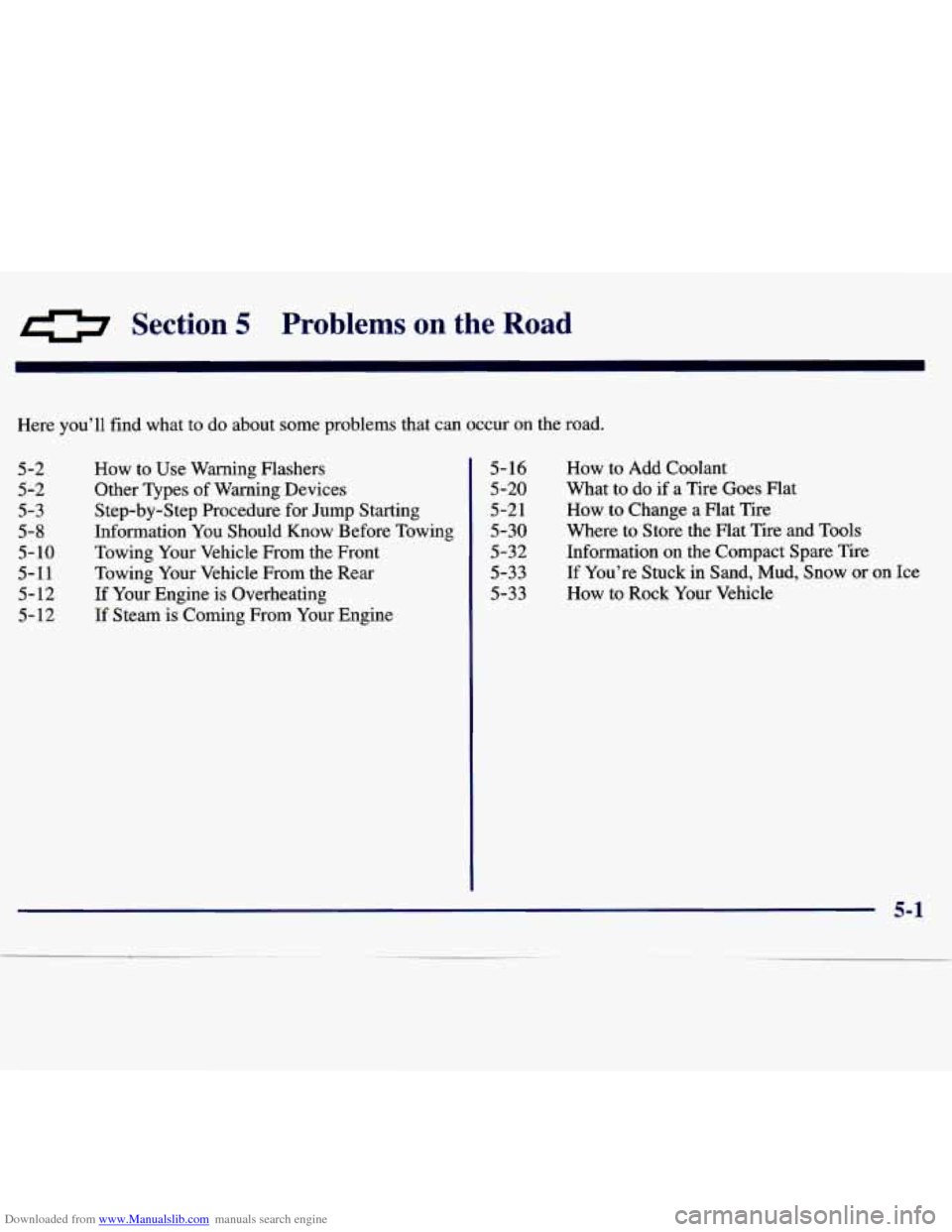
Downloaded from www.Manualslib.com manuals search engine 0 Sectio 5 Problems on the Road
Here you’ll find what to do about some problems that can occur on the road.
5-2
5-2
5-3
5-8
5- 10
5-11
5- 12
5- 12
How to Use Warning Flashers
Other Types of Warning Devices
Step-by-step Procedure for Jump Starting
Information You Should Know Before Towing
Towing Your Vehicle From the Front
Towing Your Vehicle From the Rear
If Your Engine is Overheating
If Steam is Coming From Your Engine
5-16 How to Add Coolant
5 -20 What to do if a Tire Goes Flat
5-2 1 How to Change a Flat Tire
5-30 Where to Store the Flat Tire and Tools
5-32 Information on the Compact Spare Tire
5-33 If You’re Stuck in Sand, Mud, Snow or on Ice
5-33 How to Rock Your Vehicle
5-1
Page 199 of 354
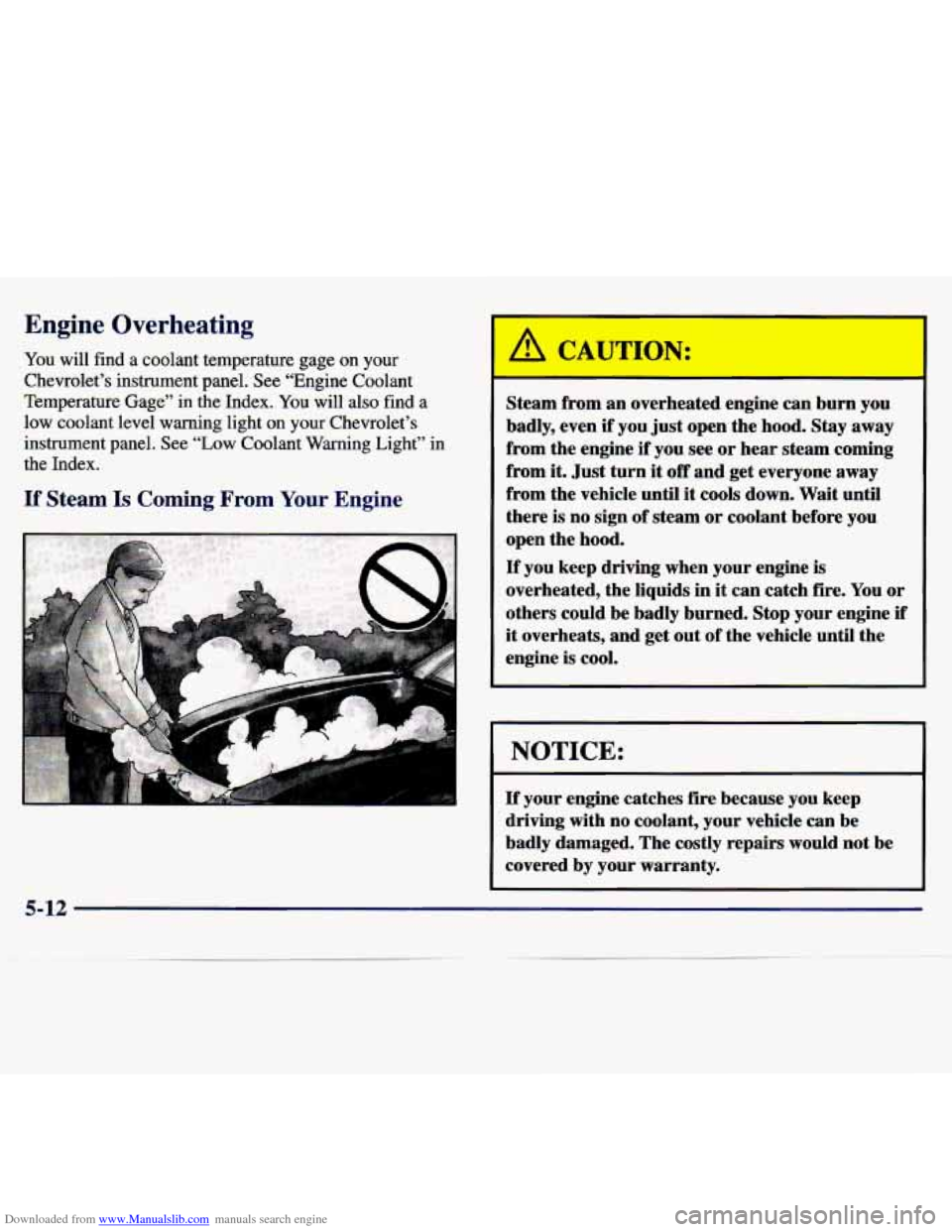
Downloaded from www.Manualslib.com manuals search engine Engine Overheating I1
You will find a coolant temperature gage on your
Chevrolet’s instrument panel. See “Engine Coolant
Temperature Gage’’
in the Index. You will also find a
low coolant level warning light on your Chevrolet’s
instrument panel. See
“LOW Coolant Warning Light” in
the Index.
If Steam Is Coming From ’ hgine
I I
Steam from an overheated engine can burn you
badly, even if you just open the hood. Stay away
from the engine if you see or hear steam coming
from it. Just turn it
off and get everyone away
from the vehicle until it cools down. Wait until
there is no sign
of steam or coolant before you
open the hood.
If you keep driving when your engine is
overheated, the liquids in it can catch fire. You
or
others could be badly burned. Stop your engine if
it overheats, and get out of the vehicle until the
engine is cool.
1 NOTICE: I
If your engine catches fire because you keep
driving
with no coolant, your vehicle can be
badly damaged. The costly repairs would not be
covered by your warranty.